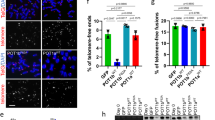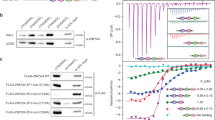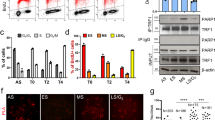Abstract
Telomeres were originally defined as chromosome caps that prevent the natural ends of linear chromosomes from undergoing deleterious degradation and fusion events. POT1 (protection of telomeres) protein binds the single-stranded G-rich DNA overhangs at human chromosome ends and suppresses unwanted DNA repair activities. TPP1 is a previously identified binding partner of POT1 that has been proposed to form part of a six-protein shelterin complex at telomeres. Here, the crystal structure of a domain of human TPP1 reveals an oligonucleotide/oligosaccharide-binding fold that is structurally similar to the β-subunit of the telomere end-binding protein of a ciliated protozoan, suggesting that TPP1 is the missing β-subunit of human POT1 protein. Telomeric DNA end-binding proteins have generally been found to inhibit rather than stimulate the action of the chromosome end-replicating enzyme, telomerase. In contrast, we find that TPP1 and POT1 form a complex with telomeric DNA that increases the activity and processivity of the human telomerase core enzyme. We propose that POT1–TPP1 switches from inhibiting telomerase access to the telomere, as a component of shelterin, to serving as a processivity factor for telomerase during telomere extension.
This is a preview of subscription content, access via your institution
Access options
Subscribe to this journal
Receive 51 print issues and online access
$199.00 per year
only $3.90 per issue
Buy this article
- Purchase on Springer Link
- Instant access to full article PDF
Prices may be subject to local taxes which are calculated during checkout




Similar content being viewed by others
References
Blackburn, E. H. Switching and signaling at the telomere. Cell 106, 661–673 (2001)
Cech, T. R. Beginning to understand the end of the chromosome. Cell 116, 273–279 (2004)
Shay, J. W. & Wright, W. E. Telomerase: a target for cancer therapeutics. Cancer Cell 2, 257–265 (2002)
Chong, L. et al. A human telomeric protein. Science 270, 1663–1667 (1995)
Broccoli, D., Smogorzewska, A., Chong, L. & de Lange, T. Human telomeres contain two distinct Myb-related proteins, TRF1 and TRF2. Nature Genet. 17, 231–235 (1997)
Baumann, P. & Cech, T. R. Pot1, the putative telomere end-binding protein in fission yeast and humans. Science 292, 1171–1175 (2001)
Baumann, P., Podell, E. & Cech, T. R. Human Pot1 (protection of telomeres) protein: cytolocalization, gene structure, and alternative splicing. Mol. Cell. Biol. 22, 8079–8087 (2002)
Hockemeyer, D., Daniels, J. P., Takai, H. & de Lange, T. Recent expansion of the telomeric complex in rodents: Two distinct POT1 proteins protect mouse telomeres. Cell 126, 63–77 (2006)
Wu, L. et al. Pot1 deficiency initiates DNA damage checkpoint activation and aberrant homologous recombination at telomeres. Cell 126, 49–62 (2006)
Lei, M., Podell, E. R. & Cech, T. R. Structure of human POT1 bound to telomeric single-stranded DNA provides a model for chromosome end-protection. Nature Struct. Mol. Biol. 11, 1223–1229 (2004)
Loayza, D. & de Lange, T. POT1 as a terminal transducer of TRF1 telomere length control. Nature 423, 1013–1018 (2003)
Ye, J. Z. et al. POT1-interacting protein PIP1: a telomere length regulator that recruits POT1 to the TIN2/TRF1 complex. Genes Dev. 18, 1649–1654 (2004)
Liu, D. et al. PTOP interacts with POT1 and regulates its localization to telomeres. Nature Cell Biol. 6, 673–680 (2004)
Houghtaling, B. R., Cuttonaro, L., Chang, W. & Smith, S. A dynamic molecular link between the telomere length regulator TRF1 and the chromosome end protector TRF2. Curr. Biol. 14, 1621–1631 (2004)
Kim, S. H., Kaminker, P. & Campisi, J. TIN2, a new regulator of telomere length in human cells. Nature Genet. 23, 405–412 (1999)
Liu, D. O’connor, M. S., Qin, J. & Songyang, Z. Telosome, a mammalian telomere-associated complex formed by multiple telomeric proteins. J. Biol. Chem. 279, 51338–51342 (2004)
Ye, J. Z. et al. TIN2 binds TRF1 and TRF2 simultaneously and stabilizes the TRF2 complex on telomeres. J. Biol. Chem. 279, 47264–47271 (2004)
O’Connor, M. S., Safari, A., Xin, H., Liu, D. & Songyang, Z. A critical role for TPP1 and TIN2 interaction in high-order telomeric complex assembly. Proc. Natl Acad. Sci. USA 103, 11874–11879 (2006)
Kim, S. H. et al. TIN2 mediates functions of TRF2 at human telomeres. J. Biol. Chem. 279, 43799–43804 (2004)
Li, B., Oestreich, S. & de Lange, T. Identification of human Rap1: implications for telomere evolution. Cell 101, 471–483 (2000)
de Lange, T. Shelterin: the protein complex that shapes and safeguards human telomeres. Genes Dev. 19, 2100–2110 (2005)
Hicke, B. J., Celander, D. W., MacDonald, G. H., Price, C. M. & Cech, T. R. Two versions of the gene encoding the 41-kilodalton subunit of the telomere binding protein of Oxytricha nova. Proc. Natl Acad. Sci. USA 87, 1481–1485 (1990)
Horvath, M. P., Schweiker, V. L., Bevilacqua, J. M., Ruggles, J. A. & Schultz, S. C. Crystal structure of the Oxytricha nova telomere end binding protein complexed with single strand DNA. Cell 95, 963–974 (1998)
Gray, J. T., Celander, D. W., Price, C. M. & Cech, T. R. Cloning and expression of genes for the Oxytricha telomere-binding protein: specific subunit interactions in the telomeric complex. Cell 67, 807–814 (1991)
Loayza, D., Parsons, H., Donigian, J., Hoke, K. & de Lange, T. DNA binding features of human POT1: a nonamer 5′-TAGGGTTAG-3′ minimal binding site, sequence specificity, and internal binding to multimeric sites. J. Biol. Chem. 279, 13241–13248 (2004)
Lei, M., Zaug, A. J., Podell, E. R. & Cech, T. R. Switching human telomerase on and off with hPOT1 protein in vitro. J. Biol. Chem. 280, 20449–20456 (2005)
Fang, G. W. & Cech, T. R. Molecular cloning of telomere-binding protein genes from Stylonychia mytilis. Nucleic Acids Res. 19, 5515–5518 (1991)
Fang, G., Gray, J. T. & Cech, T. R. Oxytricha telomere-binding protein: separable DNA-binding and dimerization domains of the α-subunit. Genes Dev. 7, 870–882 (1993)
Fang, G. & Cech, T. R. The β subunit of Oxytricha telomere-binding protein promotes G-quartet formation by telomeric DNA. Cell 74, 875–885 (1993)
Paeschke, K., Simonsson, T., Postberg, J., Rhodes, D. & Lipps, H. J. Telomere end-binding proteins control the formation of G-quadruplex DNA structures in vivo. Nature Struct. Mol. Biol. 12, 847–854 (2005)
Dietmann, S. & Holm, L. Identification of homology in protein structure classification. Nature Struct. Biol. 8, 953–957 (2001)
Theobald, D. L., Mitton-Fry, R. M. & Wuttke, D. S. Nucleic acid recognition by OB-fold proteins. Annu. Rev. Biophys. Biomol. Struct. 32, 115–133 (2003)
Holm, L. & Sander, C. Database algorithm for generating protein backbone and side-chain co-ordinates from a Cα trace application to model building and detection of co-ordinate errors. J. Mol. Biol. 218, 183–194 (1991)
Chen, J. L. & Greider, C. W. Determinants in mammalian telomerase RNA that mediate enzyme processivity and cross-species incompatibility. EMBO J. 22, 304–314 (2003)
Zaug, A. J., Podell, E. R. & Cech, T. R. Human POT1 disrupts telomeric G-quadruplexes allowing telomerase extension in vitro. Proc. Natl Acad. Sci. USA 102, 10864–10869 (2005)
Kuriyan, J. & O’Donnell, M. Sliding clamps of DNA polymerases. J. Mol. Biol. 234, 915–925 (1993)
Counter, C. M. et al. Telomere shortening associated with chromosome instability is arrested in immortal cells which express telomerase activity. EMBO J. 11, 1921–1929 (1992)
Teixeira, M. T., Arneric, M., Sperisen, P. & Lingner, J. Telomere length homeostasis is achieved via a switch between telomerase-extendible and -nonextendible states. Cell 117, 323–335 (2004)
Acknowledgements
We thank Y. Chen and K. Wan for help at various stages of the project; N. F. Lue for the His-SUMO protein expression vector; Z. Songyang and T. de Lange for TPP1 cDNA; D. Yoder of beamline 23-ID at APS for assistance with data collection; and J. L. Chen and C. W. Greider for the human TERT and TER plasmids. Work in the laboratory of M.L. is supported by the American Cancer Society and the Sidney Kimmel Foundation. E.R.P., A.J.Z. and T.R.C. are supported by the Howard Hughes Medical Institute. Author Contributions F.W. is responsible for the bulk of the experiments; Y.Y. for structural determination of TPP1-OB; P.B. for crystallization of TPP1-OB; E.R.P. and A.J.Z. for the telomerase activity assays and some of the EMSA experiments; and T.R.C. and M.L. contributed to overall design and interpretation of the studies. The atomic coordinates and structure factors of TPP1-OB have been deposited in the RCSB Protein Data Bank with accession code 2146.
Author information
Authors and Affiliations
Corresponding author
Ethics declarations
Competing interests
The atomic coordinates and structure factors of TPP1-OB have been deposited in the RCSB Protein Data Bank with accession code 2I46. Reprints and permissions information is available at www.nature.com/reprints. The authors declare no competing financial interests.
Supplementary information
Supplementary Information
This file contains the Supplementary Figures 1–8, Supplementary Methods, Supplementary Table and additional references. The Supplementary Methods describes the detailed methods of protein purification, crystallization, structural determination, and snake-venom phosphodiesterase I digestion assay. (PDF 4673 kb)
Rights and permissions
About this article
Cite this article
Wang, F., Podell, E., Zaug, A. et al. The POT1–TPP1 telomere complex is a telomerase processivity factor. Nature 445, 506–510 (2007). https://doi.org/10.1038/nature05454
Received:
Accepted:
Published:
Issue Date:
DOI: https://doi.org/10.1038/nature05454
This article is cited by
-
The regulations of telomerase reverse transcriptase (TERT) in cancer
Cell Death & Disease (2024)
-
Genetics of human telomere biology disorders
Nature Reviews Genetics (2023)
-
A pan-sarcoma landscape of telomeric content shows that alterations in RAD51B and GID4 are associated with higher telomeric content
npj Genomic Medicine (2023)
-
Orchestrating nucleic acid–protein interactions at chromosome ends: telomerase mechanisms come into focus
Nature Structural & Molecular Biology (2023)
-
Conformational plasticity and allosteric communication networks explain Shelterin protein TPP1 binding to human telomerase
Communications Chemistry (2023)
Comments
By submitting a comment you agree to abide by our Terms and Community Guidelines. If you find something abusive or that does not comply with our terms or guidelines please flag it as inappropriate.



